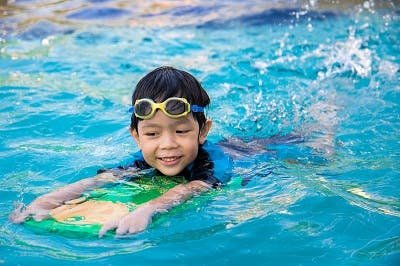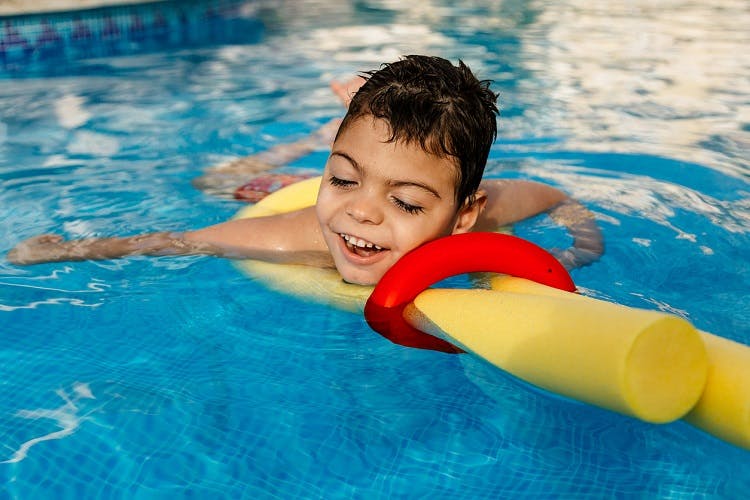Can aquatic therapy help individuals with cerebral palsy improve their mobility?
Aquatic therapy is a type of rehabilitative therapy that takes place in a pool. It makes it fun and motivating to participate in physical activity.
Additionally, water has several unique properties that may help individuals with cerebral palsy improve their functional mobility.
This article will go over the various techniques involved in aquatic therapy and how they can benefit individuals with cerebral palsy.
What to Expect at Aquatic Therapy for Cerebral Palsy
Everyone experiences cerebral palsy differently. Therefore, the methods used in aquatic therapy will vary depending on the individual’s specific needs.
Aquatic therapy for cerebral palsy can involve various water-based exercises, including:
- Walking (or skipping, galloping, or running) in shallow/deep water
- Aquatic yoga
- Swimming
- Floating
- Motion exercises
- Resistance exercises
- Balance exercises
- Games
- Deep breathing exercises
- Stretching
Floatation devices (vests, barbells, resistance bands, noodles, boards) are used to help keep individuals’ heads out of the water. They ensure extra safety so that individuals can focus on their movements.
Moreover, the exercises are guided by a physical or occupational therapist, so parents can feel assured that their children will be safe.
In the following section, we’ll discuss the benefits of aquatic therapy and how it can help individuals with cerebral palsy improve their mobility.
Benefits of Aquatic Therapy for Cerebral Palsy

Aquatic therapy can help individuals with CP develop a wide range of motor functions. Practicing these skills in water may help ease the transition onto land.
Benefits of aquatic therapy for cerebral palsy include improved:
- Gait
- Gross motor function
- Joint range of motion
- Cardiovascular endurance
- Posture
- Balance
- Spasticity reduction
- Circulation
Additionally, aquatic therapy can help boost one’s confidence. Because individuals may be able to move better in water than on land, they often feel more hopeful that improvements are possible. This will motivate them to move around and perform more repetitions of challenging movements to activate the brain’s neuroplasticity.
Up next, we’ll discuss why practicing exercises in water can help provide therapeutic relief and promote motor improvements.
Unique Properties of Water That Promote Rehabilitation
There are 4 unique properties of water that make aquatic therapy ideal for individuals with cerebral palsy.
Below, we’ll discuss these properties and how they can help individuals with cerebral palsy improve their motor skills:
1. Buoyancy
Participating in aquatic therapy allows individuals with cerebral palsy to take advantage of buoyancy. Buoyancy is what decreases the effect of gravity and keeps individuals afloat when submerged in water.
It makes you feel weightless and relieves pressure off the joints, which makes it easier for individuals to focus on their movements. It may even allow you to stand when you would be unable to do so on land due to lower body weakness.
2. Viscosity
Another beneficial property of water is viscosity. Viscosity is how much resistance a fluid has. For example, water is less viscous than honey.
Viscosity is what makes it challenging to walk quickly underwater. There’s much more resistance when walking in water than walking on land.
Because individuals have to push against the resistance of water to move, practicing exercises in a pool can help develop strength.
3. Hydrostatic Pressure
Hydrostatic pressure refers to the pressure of water on the body from all different directions.
Consistent pressure on the body helps decrease swelling and improve circulation. This can be especially helpful for individuals with cerebral palsy whose motor impairments make it challenging to get enough physical activity throughout the day or who are unable to move certain areas of the body.
4. Heat
Often, aquatic therapy takes place in a heated pool, which provides additional therapeutic benefits for individuals with cerebral palsy.
Heat helps increase the elasticity of soft tissue, relaxes the muscles, and reduces pain.
The following section will discuss how to maximize the effects of aquatic therapy.
How to Maximize the Effects of Aquatic Therapy
As with all forms of rehabilitative therapies for cerebral palsy, aquatic therapy focuses on promoting neuroplasticity. Neuroplasticity is the brain’s ability to make adaptive changes.
The brain damage that causes cerebral palsy does not worsen over time, so by activating neuroplasticity through repetitive stimulation, the brain may be able to reorganize itself to strengthen and improve movement patterns.
The most effective way to replace a poor habit is to practice a new, challenging task. Being submerged in the water adds a completely new challenge to walking, so it fires a whole new set of neural pathways in the brain than walking on land. This could result in a better gait pattern, even when walking outside of the pool. The more you repeat the action, the stronger the neural pathways for it become.
Additionally, aquatic therapy serves as a fun form of physical activity. Finding what keeps your child motivated is essential for keeping them engaged and performing the repetitions they need to improve.
Aquatic Therapy for Cerebral Palsy: Key Points
Aquatic therapy for cerebral palsy is a popular alternative to traditional exercises on land.
The change of environment helps keeps kids engaged and physically active. Additionally, practicing exercises in water allows for less pressure on the joints, develops strength, and improves circulation.
We hope this article helped you understand how aquatic therapy may help individuals with CP improve their motor functions.











